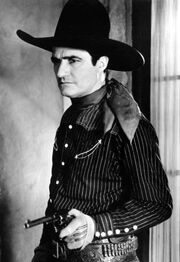
Tom Mix
Thomas Hezikiah Mix (1880-1940) American Actor, Supervisor, Writer, Producer and Director. The son of a lumberman, Tom Mix joined the army as a young man and was an artillery sergeant during the Philippine campaign from 1898 to 1901, though he never saw action. In fact, Mix deserted from the army and carefully kept the facts about his military service a closely guarded secret. About 1903 he was drum major with the Oklahoma Cavalry Band, playing in the St. Louis World's Fair. In 1904 he was a bartender and sheriff/marshal in Dewey, Oklahoma. He was in a series of Wild West shows, such as The Miller Bros. Wild West Show, from 1906-1909; the Widerman show in Amarillo, Texas; with wife Olive Mix in Seattle's Alaska-Yukon-Pacific Exposition; and Will A. Dickey's Circle D Ranch. The latter supplied Selig Pictures with cowboys and Indians for movies and, in 1910, Mix was hired by Selig to provide and handle horses. His first movie was Ranch Life in the Great Southwest (1910). He continued with Selig until 1917, writing and directing as well as acting. He was signed by Fox Films in 1917 and remained with them until 1928, averaging five or so films a year. His popularity eclipsed all other great cowboy stars (Hoot Gibson and even the legendary William S. Hart) of the silent era and he earned--and spent--millions.
In addition to Mix's riding and shooting skills, the films also showcased the talents of his amazing horse, Tony the Horse. Sound and encroaching middle age were not favorable to Mix, and after making a handful of pictures during the sound era he left the film industry after 1935's serial, The Miracle Rider (1935) (a huge hit for lowly Mascot Pictures, grossing over $1 million; Mix earned $40,000), touring with the Sells Floto Circus in 1930 and 1931 and the Tom Mix Circus from 1936 to 1938. While Mix was a great showman, the combination of the Depression and the high overhead of his traveling shows conspired against his success. Mix developed a comical style, emphasizing fast action thrills to a greater extent than had been common in earlier westerns, and he did his own stunts. He was king of the cowboys during the 1920s and remained popular on radio and in comic books for more than a decade after his death. He died in an auto accident in 1940. Although he did ride several horses, Tony was among his favorite, the others were named "Tony, Jr." and "Old Blue".
Section heading[]
Write the first section of your page here.
Section heading[]
Write the second section of your page here.